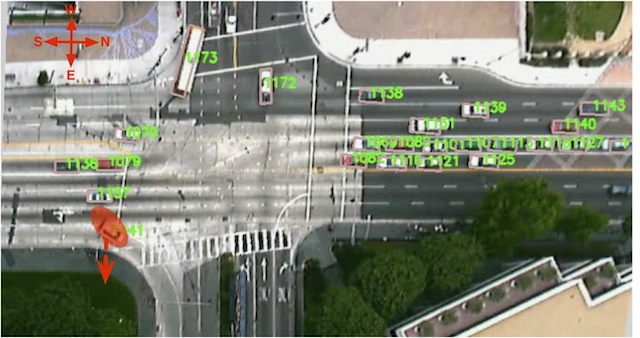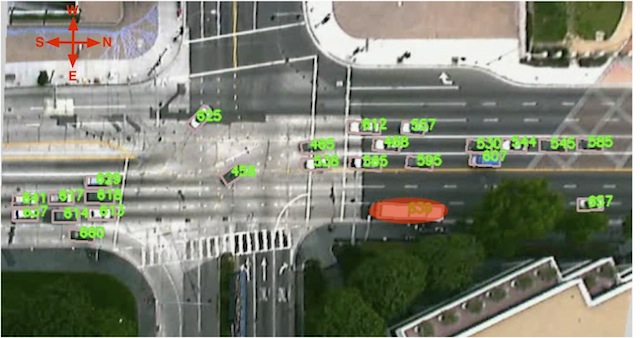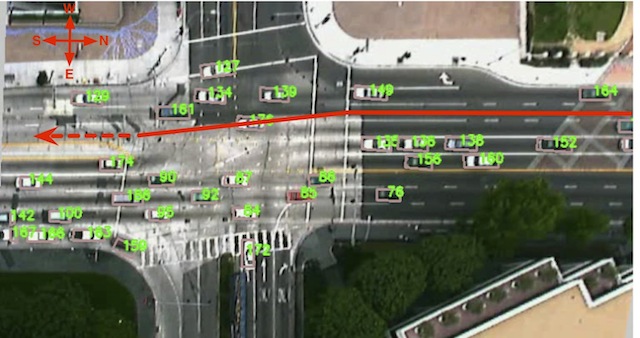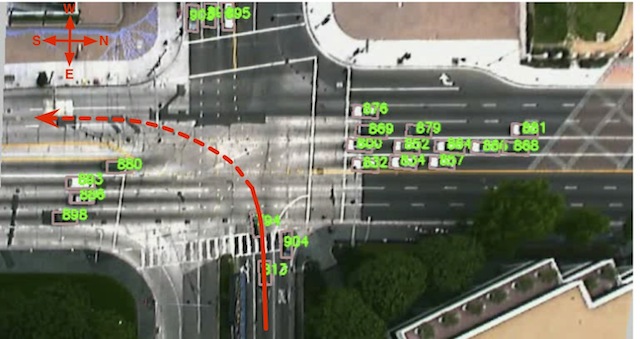Video Anomaly Detection in Spatiotemporal Context
Fan Jiang, Junsong Yuan, Sotirios A. Tsaftaris, and Aggelos K. KatsaggelosAbstract
We propose a context-aware method to detect anomalous video event from surveillance video. By tracking all moving objects in the video, three different levels of spatiotemporal contexts are considered, i.e., point anomaly of a video object, sequential anomaly of an object trajectory, and co-occurrence anomaly of multiple video objects. A hierarchical data mining approach is proposed. At each level, frequency based analysis is performed to automatically discover regular rules of normal events. Events deviating from these rules are identified as anomalies. The proposed method is computationally efficient and can infer complex rules. Experiments on real traffic video validate that the detected video anomalies are hazardous or illegal according to traffic regulations.
Application Scenario
As a case study, we have selected a surveillance video monitoring traffic for a long time at a 4-way road intersection. Each road is a two-way road with multiple lanes (some with right turn or left turn lanes). All moving traffic in this area is controlled by traffic lights within the intersection. Thus, the underlying rule of normal motion is the legal motion directed by the traffic lights. Detailed trajectory information for every vehicle is available. However, with the information of traffic signaling unknown, our goal is to discover traffic rules followed by most vehicles in this area and to detect anomalies at different levels.
| Press image to see video |
 |
Figure 1. Video monitoring traffic at road intersection (image: all lanes are numbered from 1 to 29 and the intersection area is numbered as 30; video: tracked vehicles are labeled by green numbers).
Point Anomaly Detection
Detecting anomalous instaneous motion of a single object.
| Press image to see video |
 |
 |
| (a) | (b) |
Figure 2. Example results of point anomaly (red blob in image, red cross in video) : (a) shows a vehicle (indicated by a red ellipse) moving eastwards, since it moves sharply from lane 4 to lane 5 (see Fig. 1); (b) shows one vehicle stopping in lane 12 (see Fig. 1) right after leaving the intersection.
Sequential Anomaly Detection
Detecting anomalous part of a single object trajectory.
| Press image to see video |
 |
 |
| (a) | (b) |
Figure 3. Example results of sequential anomaly (red dashed line in image, red cross in video) : (a) shows a vehicle changing lane within the intersection; (b) shows a vehicle making a left turn from a no-turn lane. Both of them are illegal behaviors.
Co-occurrence Anomaly Detection
Detecting anomalous co-occurring of multiple objects at one time.
| Press image to see video |
 |
 |
| (a) | (b) |
Figure 4. Example results of co-occurrence anomaly (red dashed line in image, red cross in video) : (a) shows two vehicles turning into the same lane; (b) shows a vehicle entering the intersection (passing the waiting line) trying to turn left when the left-turning light is red. Both of them are illegal behaviors.
Publications
- Fan Jiang, Junsong Yuan, Sotirios A. Tsaftaris, and Aggelos K. Katsaggelos, "Anomalous Video Event Detection Using Spatiotemporal Context", to appear in Computer Vision and Image Understanding Special Issue on Feature-Oriented Image and Video Computing for Extracting Contexts and Semantics, 2010. [PDF]
- Fan Jiang, Junsong Yuan, Sotirios A. Tsaftaris, and Aggelos K. Katsaggelos, "Video Anomaly Detection in Spatiotemporal Context," to appear in Proc. IEEE Int'l Conf. on Image Process., Hong Kong, Sept 2010. [PDF]